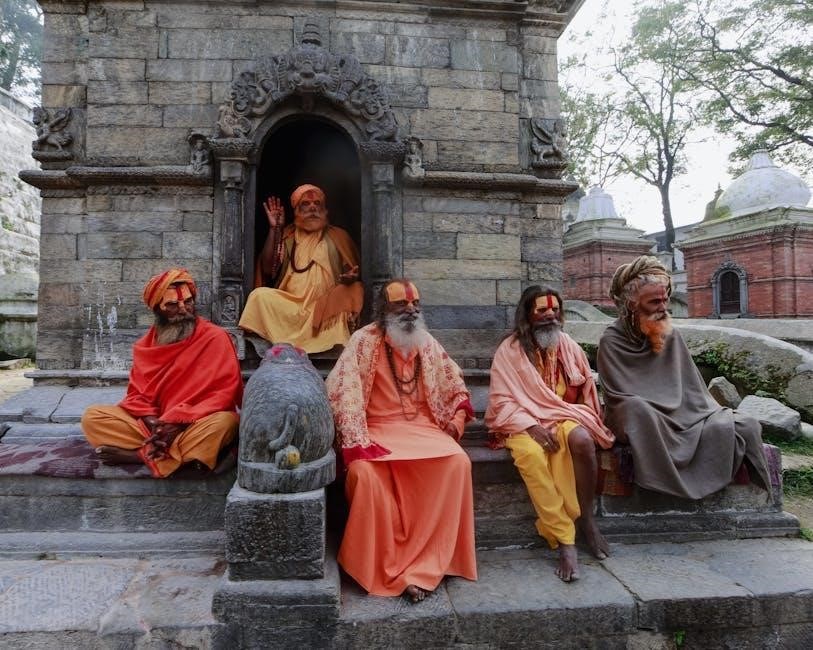Bhagavad Gita in Sanskrit PDF: A Comprehensive Guide (Updated 11/25/2025)
Today, November 25, 2025, access the original Bhagavad Gita in Sanskrit PDF format! Explore free downloads, transliterations, and commentaries from reliable sources, including Sankara, Ramanuja, and Radhakrishnan’s interpretations․
The Bhagavad Gita, a cornerstone of Hindu philosophy, is a 700-verse scripture embedded within the epic Mahabharata․ It presents a dialogue between Arjuna and Lord Krishna on the Kurukshetra battlefield, exploring themes of duty, devotion, and the nature of reality․ Accessing the Bhagavad Gita in its original Sanskrit offers a profound connection to its ancient wisdom․
Numerous PDF versions are available online, allowing devotees and scholars to study the text directly․ These resources often include transliteration, aiding those unfamiliar with the Deva Bhasha script, and insightful commentaries from esteemed philosophers like Sankara, Ramanuja, and Radhakrishnan․ The availability of these Sanskrit PDFs facilitates deeper understanding and personal reflection on the Gita’s timeless teachings․
The Significance of the Sanskrit Text

Sanskrit, revered as Deva Bhasha – the language of the gods – holds immense significance for the Bhagavad Gita․ The original verses, composed in precise Sanskrit meter and grammar, carry nuances often lost in translation․ Studying the Bhagavad Gita in Sanskrit PDF format allows for a direct engagement with these subtleties, unlocking deeper layers of meaning․
The phonetic precision of Sanskrit is believed to imbue the text with spiritual power․ Accessing the scripture in its original language, through readily available PDFs, provides a more authentic experience․ Furthermore, understanding the Sanskrit grammar, taught in classes 11 & 12, enhances comprehension and appreciation of the Gita’s philosophical depth, offering a richer, more profound connection to its wisdom․
Availability of Bhagavad Gita in Sanskrit PDF Format
Numerous resources offer the Bhagavad Gita in Sanskrit PDF format, making this sacred text widely accessible․ Reliable websites provide free downloads, often including transliterations and commentaries by esteemed scholars like Sankara, Ramanuja, and Radhakrishnan․ These PDFs frequently contain the original Sanskrit verses alongside English and Hindi translations for comparative study․
You can find complete editions encompassing all 18 chapters, with word-for-word translations to aid understanding․ Moreover, the availability extends to mobile-friendly PDF formats and dedicated apps, allowing for convenient study on various devices; Downloading the Bhagavad Gita in Sanskrit PDF is now easier than ever, fostering deeper spiritual exploration․
Free Download Sources

Several online platforms offer the Bhagavad Gita in Sanskrit PDF for free download․ These sources cater to both scholarly and devotional pursuits, providing access to the original scripture․ Many websites specialize in Hindu texts, hosting high-quality PDFs of the Gita, often with accompanying transliterations and commentaries․
Look for sites dedicated to Sanskrit literature or those affiliated with reputable Hindu organizations․ Be mindful of website credibility to ensure the PDF is authentic and complete․ Downloading from trusted sources guarantees access to accurate versions of the Bhagavad Gita, facilitating a meaningful study experience․ Explore these resources to begin your journey!

Reliable Websites for Sanskrit PDFs
Finding authentic Bhagavad Gita Sanskrit PDFs requires utilizing trustworthy online resources․ Several websites consistently provide high-quality, accurate versions of the scripture․ Look to platforms specializing in Hindu texts and Sanskrit literature for reliable downloads․
Archive․org often hosts digitized versions of classic texts․ Additionally, websites associated with established Hindu organizations and scholarly institutions are excellent sources․ Always verify the source’s reputation before downloading to ensure the PDF is complete and free from errors․ Prioritize sites offering transliteration and commentary alongside the Sanskrit text for a richer learning experience․
PDFs with Transliteration and Commentary
Many Bhagavad Gita Sanskrit PDF resources enhance understanding with accompanying transliteration and insightful commentaries․ These features are invaluable for students and practitioners unfamiliar with the Sanskrit script or nuanced philosophical concepts․
PDFs offering transliteration present the Sanskrit verses in a Roman script format, aiding pronunciation and comprehension․ Commentaries, often drawn from the works of esteemed scholars like Sankara, Ramanuja, and Radhakrishnan, provide context and interpretations․ These layered resources unlock deeper meaning within the verses․ Seeking PDFs with word-for-word translations further clarifies the text, making the Gita accessible to a wider audience․
Understanding the Structure of the Gita
The Bhagavad Gita, contained within the epic Mahabharata, is structured as a dialogue between Arjuna and Krishna on the Kurukshetra battlefield․ A Sanskrit PDF reveals this carefully organized composition․ The scripture comprises 18 chapters, each addressing a specific aspect of spiritual knowledge and practice․
These chapters progressively unfold the teachings of Yoga – Karma Yoga, Bhakti Yoga, and Jnana Yoga – offering diverse paths to liberation․ Understanding this structure, readily apparent in a Sanskrit PDF, is crucial for grasping the Gita’s holistic philosophy․ The verses build upon each other, creating a cohesive and profound spiritual discourse․
The 18 Chapters: An Overview
A Sanskrit PDF of the Bhagavad Gita reveals its 18 chapters systematically explore dharma, devotion, and liberation․ Chapters 1-6 lay the foundation, introducing Arjuna’s dilemma and Krishna’s initial teachings on selfless action – Karma Yoga․ Chapters 7-12 delve into the path of devotion – Bhakti Yoga – emphasizing Krishna’s divine nature․
Chapters 13-18 focus on Jnana Yoga, the path of knowledge, dissecting the nature of reality, the self, and the ultimate goal of life․ Examining a Sanskrit PDF highlights the interconnectedness of these paths․ Each chapter builds upon the previous, offering a comprehensive spiritual guide․ The final chapters emphasize renunciation and the importance of unwavering faith․
Key Characters: Krishna, Arjuna, and Sanjaya
A Sanskrit PDF of the Bhagavad Gita centers around three pivotal characters․ Krishna, the divine charioteer and avatar of Vishnu, imparts profound wisdom․ Arjuna, the warrior prince, embodies human struggle and seeks guidance on dharma․ Their dialogue forms the core of the scripture․
Sanjaya, the royal narrator, relays this sacred conversation to King Dhritarashtra, providing a crucial perspective on the unfolding events at Kurukshetra․ Studying the text in Sanskrit PDF format reveals nuances in their interactions․ Sanjaya’s role is unique, possessing divine vision to witness and recount the Gita’s teachings․ These characters represent the seeker, the guide, and the witness․
Sanskrit Grammar and the Bhagavad Gita
Understanding Sanskrit grammar is crucial when studying the Bhagavad Gita in its original PDF form․ The text employs complex grammatical structures, including sandhi (euphonic combination of sounds) and various case endings․ A solid grasp of these elements unlocks deeper layers of meaning․
Students in classes 11 & 12 often begin their Sanskrit journey with foundational grammar, preparing them for texts like the Gita, written in Deva Bhasha․ Analyzing the verb conjugations and noun declensions within the Sanskrit PDF reveals the precision and artistry of the original composition․ Accurate grammatical understanding is essential for correct interpretation and appreciation of the Gita’s philosophical depth․
Sanskrit Learning in Classes 11 & 12
Sanskrit education in classes 11 & 12 lays a vital foundation for engaging with texts like the Bhagavad Gita in its original PDF format․ The curriculum typically introduces core grammatical concepts and vocabulary, preparing students to decipher Deva Bhasha, the language of many Hindu scriptures․
This structured approach enables students to eventually tackle the complexities of the Gita’s Sanskrit PDF, understanding its verses with greater nuance․ The syllabus often includes studying classical Sanskrit literature, building analytical skills necessary for interpreting philosophical texts․ Mastering basic grammar during these years is key to unlocking the wisdom contained within the Bhagavad Gita․
Deva Bhasha and Hindu Texts
Deva Bhasha, often referred to as “the language of the gods,” is the classical Sanskrit in which many foundational Hindu texts, including the Bhagavad Gita, are composed․ Accessing the Bhagavad Gita in its original Sanskrit PDF form requires familiarity with this language, allowing for a direct connection to the scripture’s profound meaning․
Understanding Deva Bhasha unlocks layers of interpretation often lost in translation․ The Bhagavad Gita’s verses, when read in Sanskrit, reveal subtle nuances of philosophy and spirituality․ Studying the text in its original language, via a PDF, provides a deeper appreciation for its poetic beauty and philosophical depth, essential for serious scholars and devotees․

Different Commentaries and Translations

While the original Bhagavad Gita in Sanskrit PDF offers purity, numerous commentaries illuminate its complex teachings․ Exploring these diverse perspectives enhances understanding․ Key commentators include Sankara, known for Advaita Vedanta, Ramanuja, representing Vishishtadvaita, and Radhakrishnan, offering a modern, philosophical interpretation․
Accessing a Sanskrit PDF alongside these commentaries provides a comparative study opportunity․ Translations, while helpful, can introduce interpretive biases․ Examining the original Sanskrit alongside various commentaries – Sankara, Ramanuja, and RN Radhakrishnan – allows readers to discern the core message and appreciate the richness of the Gita’s philosophical landscape․
Sankara’s Commentary
Sankara’s commentary on the Bhagavad Gita, often studied alongside a Sanskrit PDF of the original text, is foundational to Advaita Vedanta philosophy․ He interprets the Gita as a path to realizing the non-dual nature of reality – the ultimate oneness of the individual self (Atman) with the universal Brahman․
His approach emphasizes jnana yoga, the path of knowledge, as the primary means to liberation․ Studying the Gita with Sankara’s commentary clarifies how action (karma) can be performed without attachment, leading to detachment and ultimately, self-realization․ Accessing a Sanskrit PDF alongside his work allows for a deeper understanding of the nuances within the original verses․
Ramanuja’s Commentary
Ramanuja’s commentary on the Bhagavad Gita presents a contrasting perspective to Sankara’s, rooted in Vishishtadvaita Vedanta – qualified non-dualism․ When studying a Sanskrit PDF of the Gita alongside Ramanuja’s work, one discovers an emphasis on devotion (bhakti yoga) as the primary path to liberation․

He interprets the Gita to highlight the loving relationship between the individual soul and the Supreme Being, Vishnu․ Ramanuja argues that Brahman is not merely formless, but possesses auspicious qualities and is accessible through sincere devotion․ His commentary, when paired with the original Sanskrit PDF, reveals a path where grace and surrender are key to achieving moksha․
Radhakrishnan’s Commentary
Sarvepalli Radhakrishnan’s commentary on the Bhagavad Gita offers a modern and philosophical interpretation, bridging Eastern wisdom with Western thought․ Examining a Sanskrit PDF of the Gita alongside his work reveals a focus on the ethical and spiritual relevance of the text for contemporary life․

Radhakrishnan presents the Gita as a call to action, emphasizing the importance of selfless service (karma yoga) and the realization of the divine within․ His approach is inclusive, acknowledging the validity of different paths to truth․ Studying his commentary alongside the original Sanskrit PDF provides a nuanced understanding of the Gita’s universal message, appealing to a broad audience seeking spiritual guidance․

The Philosophical Core of the Bhagavad Gita
The Bhagavad Gita’s philosophical heart, accessible through a Sanskrit PDF, centers on the interconnectedness of dharma, karma, and moksha․ It explores the nature of reality, the self (Atman), and the ultimate reality (Brahman)․ The text doesn’t advocate renunciation, but rather skillful action performed without attachment to results․
Studying the Gita in its original Sanskrit PDF reveals the subtle interplay of these concepts․ It presents three primary paths – Karma Yoga (the path of action), Bhakti Yoga (the path of devotion), and Jnana Yoga (the path of knowledge) – as means to liberation․ The Gita emphasizes that these paths aren’t mutually exclusive, offering a holistic approach to spiritual realization․
Karma Yoga

Karma Yoga, as detailed within a Bhagavad Gita Sanskrit PDF, isn’t simply about performing actions; it’s about performing them selflessly, without attachment to outcomes․ The Gita stresses dedicating all actions to the divine, relinquishing ownership of results․ This detachment purifies the mind and fosters inner peace․
Accessing the Gita in its original Sanskrit PDF allows for a deeper understanding of the nuances of karma․ It clarifies that action is unavoidable, but the intention behind it determines its consequences․ Through disciplined action, one transcends the cycle of birth and death, achieving liberation․ The Gita advocates for fulfilling one’s dharma – duty – with unwavering dedication, embodying Karma Yoga’s core principle․
Bhakti Yoga
Bhakti Yoga, illuminated within a Bhagavad Gita Sanskrit PDF, centers on the path of devotion and love towards the divine․ The Gita emphasizes surrendering to a higher power, cultivating a personal relationship with Krishna through unwavering faith and heartfelt worship․ This path is accessible to all, regardless of social standing or intellectual capacity․
Studying the Gita in its original Sanskrit PDF reveals the depth of this devotion․ It details various forms of bhakti – from chanting and prayer to selfless service – all aimed at uniting the individual soul with the universal consciousness․ The text highlights Krishna’s compassionate nature and encourages a loving, reciprocal connection․ Bhakti Yoga offers a direct and profoundly fulfilling route to spiritual realization․
Jnana Yoga
Jnana Yoga, as detailed within a Bhagavad Gita Sanskrit PDF, represents the path of knowledge and wisdom․ It involves rigorous self-inquiry and discrimination between the real (Brahman) and the unreal (Maya)․ This path demands intellectual discipline and a deep understanding of the Gita’s philosophical teachings․
Accessing the Gita in its original Sanskrit PDF allows for a nuanced comprehension of Jnana Yoga’s principles․ It emphasizes the realization of one’s true self, transcending the limitations of the ego and identifying with the ultimate reality․ Through contemplation and study, practitioners aim to dismantle ignorance and attain liberation․ Jnana Yoga is a challenging but rewarding path for those seeking profound spiritual insight․
The Gita’s Relevance in Today’s World
Even with readily available Bhagavad Gita Sanskrit PDFs, its wisdom remains profoundly relevant in our modern era․ The text addresses universal human dilemmas – duty, purpose, and the nature of suffering – offering timeless guidance․ In a world grappling with anxiety and uncertainty, the Gita’s teachings on equanimity and selfless action (Karma Yoga) provide a powerful antidote․
Studying the Gita, even through a digital PDF, encourages introspection and ethical conduct․ Its emphasis on detachment from results and dedication to one’s dharma resonates with contemporary challenges․ The Gita isn’t merely ancient scripture; it’s a practical philosophy for navigating life’s complexities, fostering inner peace, and promoting a more harmonious world․
Addressing Modern Challenges
Accessing the Bhagavad Gita in Sanskrit PDF format allows modern readers to directly engage with its timeless wisdom, offering solutions to contemporary issues․ The text’s teachings on detachment and righteous action provide a framework for navigating ethical dilemmas in a complex world․
PDF versions, often with transliteration, make the original accessible, fostering understanding beyond translations․ The Gita addresses anxieties surrounding purpose, success, and failure – challenges prevalent today․ Its emphasis on inner strength and fulfilling one’s duty (dharma) offers resilience against societal pressures․ Studying the Gita, even digitally, cultivates mindfulness and a balanced perspective․
Influence on Hindu Philosophy
The Bhagavad Gita, readily available as a Sanskrit PDF, stands as a cornerstone of Hindu philosophical thought․ It synthesizes diverse concepts – Karma Yoga, Bhakti Yoga, and Jnana Yoga – offering a holistic path to liberation․
Its influence extends to various schools of Vedanta, notably those of Sankara, Ramanuja, and Radhakrishnan, each interpreting the text through their unique lens․ The Gita’s articulation of dharma, moksha, and the nature of reality profoundly shaped Hindu ethics and metaphysics․ Accessing the Sanskrit PDF allows scholars and practitioners to study the original source, understanding the nuances that inform these philosophical interpretations and its enduring legacy․
Machine Translation of the Bhagavad Gita
The Bhagavad Gita, even in Sanskrit PDF format, presents significant challenges for machine translation․ Its complex poetic structure, nuanced philosophical concepts, and reliance on cultural context demand more than literal rendering․ Researchers have long been keen to translate this sacred text using computational methods, but achieving accuracy remains elusive․
The subtleties of Sanskrit grammar and the multiple layers of meaning within each verse pose hurdles for algorithms․ While machine translation can provide a basic understanding, it often fails to capture the spiritual depth and poetic beauty of the original PDF․ Ongoing research focuses on improving these translations, aiming for greater fidelity to the text’s essence․
Challenges in Translation
Translating the Bhagavad Gita, even from a Sanskrit PDF, is fraught with difficulties․ The text’s inherent poetic nature and profound philosophical depth resist straightforward conversion into other languages․ Capturing the nuances of Sanskrit grammar, particularly its complex case system and verb conjugations, proves exceptionally challenging for translators․
Furthermore, the Gita is deeply rooted in Indian culture and cosmology, requiring translators to possess not only linguistic skill but also extensive cultural understanding․ Maintaining the original text’s rhythm and aesthetic qualities while conveying its meaning accurately is a constant struggle․ The multiple interpretations and commentaries further complicate the process, demanding careful consideration of different perspectives․
Research in Gita Translation
Research into Bhagavad Gita translation, utilizing Sanskrit PDF sources, is a long-standing academic pursuit․ Numerous researchers have consistently attempted to translate this prime work in Hindu philosophy, facing considerable hurdles․ Current studies focus on employing computational linguistics and machine translation techniques to improve accuracy and accessibility․
Investigations explore methods for preserving the poetic essence and philosophical subtleties of the original Sanskrit text․ Researchers analyze existing translations, identifying common pitfalls and proposing innovative approaches․ The goal is to develop tools and methodologies that can bridge the gap between the ancient wisdom of the Gita and modern understanding, making it available to a wider audience․
The Kurukshetra Battlefield Context
The Bhagavad Gita unfolds within the dramatic setting of the Kurukshetra battlefield, a pivotal moment detailed in the Sanskrit PDF versions of the epic․ This context is crucial for understanding the dialogue between Arjuna and Krishna․ The armies of the Pandavas and Kauravas, assembled in Dharmaksetra and Kuruksetra, stand poised for a devastating war․
Sanjaya’s eyewitness account, as presented in the Sanskrit text, provides a vivid depiction of the impending conflict․ Arjuna’s moral dilemma – facing his kin in battle – forms the catalyst for Krishna’s profound teachings․ Understanding this historical and emotional backdrop, readily available within the PDF, enriches the interpretation of the Gita’s philosophical insights․
Dharmaksetra and Kuruksetra
Within the Bhagavad Gita’s Sanskrit PDF, the locations of Dharmaksetra (the field of righteousness) and Kuruksetra (the field of the Kuru dynasty) are foundational to the narrative․ These aren’t merely geographical places; they symbolize a clash between duty (dharma) and desire․ The epic begins with Dhritarashtra’s inquiry to Sanjaya about the activities unfolding on these sacred grounds․
The Sanskrit text emphasizes the significance of this battlefield as a stage for a cosmic struggle․ Accessing the PDF allows readers to appreciate the symbolic weight of these locations, representing the internal conflict within Arjuna and humanity․ The gathering of armies in Kuruksetra, as described in the Bhagavad Gita, sets the scene for Krishna’s discourse․
The Gathering of Armies
The Bhagavad Gita’s Sanskrit PDF vividly depicts the immense scale of the armies assembled at Kuruksetra․ Dhritarashtra’s anxious questioning to Sanjaya reveals a detailed account of the warriors present on both sides – the Pandavas and the Kauravas․ This initial scene, accessible within the PDF, isn’t simply a military muster; it’s a symbolic representation of conflicting ideologies and familial discord․
The Sanskrit verses emphasize the power and prowess of each warrior, highlighting the gravity of the impending battle․ Studying the PDF allows for a deeper understanding of the strategic positioning and the emotional turmoil experienced by Arjuna upon witnessing his relatives prepared for war․ This gathering sets the stage for Krishna’s teachings on dharma and duty․
Accessing the Gita on Mobile Devices
Studying the Bhagavad Gita in Sanskrit PDF format is now incredibly convenient thanks to mobile accessibility․ Numerous PDF versions are optimized for smartphones and tablets, allowing devotees and scholars to engage with the scripture on the go․ Mobile-friendly PDF readers ensure clear text display and easy navigation of the 18 chapters․
Furthermore, dedicated apps are available for studying the Gita, often incorporating features like verse-by-verse audio recitation, transliteration, and translations․ These apps enhance the learning experience, making the wisdom of Krishna readily available anytime, anywhere․ Downloading a Sanskrit PDF and utilizing these tools provides a powerful combination for spiritual growth․
Mobile-Friendly PDF Formats
When seeking a Bhagavad Gita in Sanskrit PDF for mobile devices, prioritize formats optimized for smaller screens․ Standard PDFs can be cumbersome, but versions designed with reflowable text adapt to various display sizes, enhancing readability․ Look for PDFs utilizing optimized compression techniques to minimize file size, facilitating faster downloads and reduced storage consumption․
Additionally, PDFs with embedded fonts ensure consistent rendering across different devices, preventing formatting issues․ Interactive PDFs, featuring bookmarks and hyperlinks, streamline navigation through the 18 chapters․ Choosing a well-formatted Sanskrit PDF guarantees a seamless and enriching study experience on your smartphone or tablet, allowing for convenient access to this sacred text․
Apps for Studying the Gita
Numerous mobile applications complement the study of the Bhagavad Gita in Sanskrit PDF format, offering enhanced learning experiences․ These apps often feature integrated Sanskrit text, transliteration, and English translations, alongside verse-by-verse commentaries from scholars like Sankara and Ramanuja․ Many provide audio recitations of the verses, aiding pronunciation and comprehension․
Interactive features, such as quizzes and flashcards, reinforce learning, while customizable settings allow users to adjust font sizes and themes․ Some apps include search functionality, enabling quick access to specific verses or topics․ Utilizing these apps alongside a Sanskrit PDF provides a dynamic and accessible way to delve into the Gita’s profound wisdom, fostering deeper understanding and spiritual growth․



